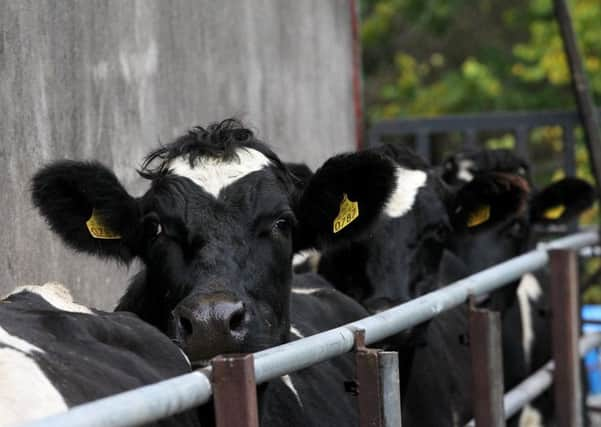Autumn action saves winter woes


Housing: moo-ving in for winter
Even the hardiest farmer will admit that it’s not much fun for us humans to be stood outside in a frigid field when winter really begins to bite. It’s no different for cowkind. That’s why the integrity of your winter housing plays a big part in keeping your herd happy when the mercury starts to drop to bovine-bothering levels.
What’s good for your herd is good for your profits too. When they are cold, cows must use more energy to maintain their core body temperature. And that energy is diverted away from milk production, which can harm your yields. The colder your cows are, the less milk they will produce.
Advertisement
Advertisement
Shelter from the rain: When you head indoors wearing a wet coat, you can take it off to get rid of the discomfort. That’s not easy when you’re a cow. That’s why it’s best to keep them dry in the first place. Energy demands increase further if the coat is wet or matted with mud.
Protection from the wind: A stiff breeze (let alone a harsh winter gale) can have a big impact on ambient air temperature. A wind speed of just 2m/s can reduce the critical temperature of your animals by 9%.
Keep their house clean and keep your eyes peeled: Would you want to sleep on a damp bed? Exactly. Each pen should have fresh, dry bedding. Watch out for cows that are shivering or have raised hair.
Nutrition: feed for warmth and milk production
Cows use more energy in the winter months simply staying warm and may require up to 20% more food to maintain bodyweight. To put it another way: cold cows eat away at potential profits through decreased milk production. So it’s important to get your dietary decisions spot on.
Advertisement
Advertisement
Lots of the wet stuff: As the temperature chills, a cow’s metabolism will automatically fire up – meaning voluntary intake of feed will increase. To support efficient digestion make sure plenty of water is available.
Increase the energy density of feed: To support the energy demands, it may be easier to increase the energy density of your ration. Consider conducting a forage analysis to be sure of your feeds energy profile.
Consider separating cows according to BCS: In an ideal world your herd will share the same body condition score. However if there are outliers, considering housing them separately based on whether they are overweight or underweight. It will make it easier for you to manage feed and eliminates feed competition from bigger cows for those that are underweight.
Consider a fat supplement: Pound for pound, fat packs the biggest energy punch of any macro-nutrient. That’s why supplementary fat can help to tackle the calorie challenge head on. A rumen-friendly supplement such as Megalac, has been proven to support milk production and boost milk fat content.
Advertisement
Advertisement
Make changes gradually – starting in autumn: It can take around three weeks for the rumen to adjust to dietary changes, during which time food may not be digested as efficiently as normal. Rapid nutritional changes can cause digestive upsets among your herd. Begin adapting your herd’s diet in autumn, when it’s also easier for them to put on weight if required.
Ventilation: a breath of fresh air
Fresh air is vital for preventing the development of respiratory diseases like pneumonia.
Utilise the stack effect: Stale air helps infiltration of pathogens and pollutants. You can keep the air moving with a clever ventilation trick called the stack effect.
Hit the fans: For some dairy farmers, fans can provide a cost-effective way of bringing some ventilation to winter housing.
Advertisement
Advertisement
Beware the draught: Regardless of your ventilation system, make sure there are no draughts at herd-height. Moving air reduces body temperature.
Control damp: Harmful pathogens survive better in damp environments. Moisture reduces air temperature too. Repair leaky downpipes and broken water feeders. Avoid soaking feed areas when it comes to cleaning. And ensure all pens have adequate drainage.
Bring in an expert: Consider running an air flow and air quality test to make sure conditions are optimised for a happy herd.
Lameness: make mobility matter
The threat of lameness is greater in winter. And the spread of infections can be rapid unless you take precautions.
Advertisement
Advertisement
Autumn – before moving your herd into winter housing – is a good time to review your foot-bathing strategy. Make sure the floor of your bath is flat, even and non-slip. The bath should also be at least three metres in length to allow cows to plod their way through with a minimum of two dips for each hoof.
Be mindful of your herd’s hooves in the parlour and look out for signs of digital dermatitis, which often lies dormant in the summer months and becomes more of a problem in winter housing.
Try to make sure at least one person on your farm is trained to score mobility using the AHDI Dairy mobility system. This helps catch developing mobility issues early so makes treatment far easier.
If you do need to treat lameness, you may wish to consider the use of a non-steroidal anti-inflammatory drug. Nottingham University researchers found that using NSAIDs alongside traditional trim and block treatment had a significant impact on lameness recovery.
Vaccination and illness: prevention is better than cure
Advertisement
Advertisement
The stress of moving indoors can temporarily weaken a cow’s immune system. Consult your veterinarian for help constructing a vaccination plan that’s effective for your farm. Because it’s true what they say. Prevention is better than cure. It also tends to be cheaper.